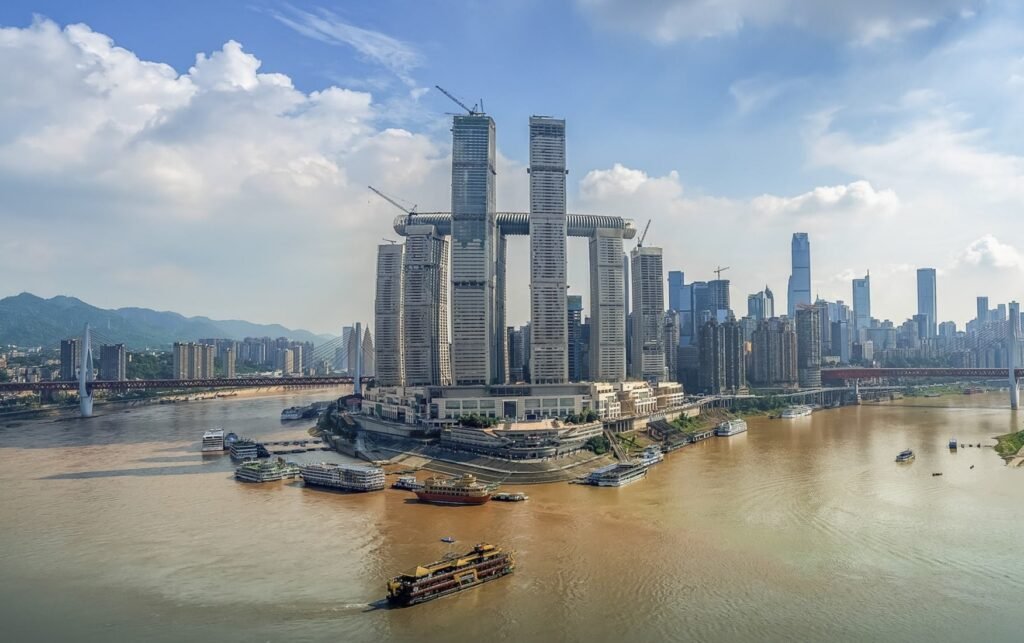(chongqing 520m building) Chongqing, a megacity in southwest China, is known for its rapid urban development and stunning skyline. Among its many architectural feats, the 520m Chongqing Building stands out as a symbol of modern engineering and design, marking a new chapter in the city’s urban growth.
2. The Vision Behind the 520m Building
The 520m building was conceived as a project to redefine Chongqing’s skyline and assert its status as a global metropolis. The vision was to create a structure that would not only be a commercial hub but also a landmark of architectural innovation.
3. Strategic Location in Chongqing
(chongqing 520m building) Located in the heart of Chongqing, the 520m building enjoys a strategic position in one of China’s most economically vibrant regions. Its location provides easy access to major transportation hubs, business districts, and cultural centers, making it a prime destination for businesses and tourists alike.
4. Architectural Design and Inspiration
The design of the 520m building draws inspiration from both modern and traditional Chinese architecture. The sleek, futuristic lines of the structure are complemented by elements that pay homage to Chongqing’s cultural heritage, creating a unique blend of the old and the new.
5. The Engineering Feat Behind the Structure
Standing at 520 meters tall, the building is an engineering marvel. The construction required the use of advanced materials and techniques to ensure stability and safety, especially given Chongqing’s seismic activity. The building’s core is reinforced with high-strength concrete and steel, making it one of the most resilient structures in the region.
6. Sustainability in Design
(chongqing 520m building) Sustainability was a key consideration in the design of the 520m building. The structure incorporates energy-efficient systems, including advanced HVAC (heating, ventilation, and air conditioning) technology, solar panels, and water recycling systems. These features help reduce the building’s environmental impact and operating costs.
7. The Mixed-Use Concept
The 520m Chongqing building is a mixed-use development, combining office spaces, luxury apartments, hotels, retail outlets, and entertainment facilities. This mix of functions makes it a self-contained vertical city, catering to a diverse range of needs and lifestyles.
8. Office Spaces with a View
(chongqing 520m building) The office spaces in the building offer panoramic views of Chongqing’s skyline and the surrounding Yangtze River. These spaces are designed with modern businesses in mind, providing state-of-the-art facilities and flexible layouts that can accommodate a variety of enterprises.
9. Luxury Living in the Sky
The residential units in the building offer luxury living with unparalleled views and top-tier amenities. Residents enjoy access to private gyms, swimming pools, and communal spaces, all designed to provide a high standard of living.
10. The Hotel Experience
The hotel within the 520m building caters to both business and leisure travelers. With its prime location and luxurious accommodations, the hotel has become a popular choice for visitors to Chongqing, offering a range of services and facilities that ensure a comfortable stay.
11. Retail and Entertainment Options
The lower floors of the building house a variety of retail outlets and entertainment venues. From high-end boutiques to gourmet restaurants and cinemas, the 520m building provides a comprehensive shopping and entertainment experience.
12. The Building’s Role in Chongqing’s Economy
The 520m building plays a significant role in Chongqing’s economy by attracting businesses, tourists, and investors. The commercial spaces generate substantial revenue, while the building’s status as a landmark boosts the city’s profile on the global stage.
13. A New Hub for Innovation
The 520m building is more than just a commercial center; it’s a hub for innovation. The building hosts tech companies, startups, and research institutions, fostering collaboration and creativity. This environment encourages the development of new ideas and technologies that can drive future growth.
14. Cultural Significance
The building also serves as a cultural landmark, hosting art exhibitions, cultural events, and public performances. These events celebrate Chongqing’s rich history and contemporary culture, making the building a focal point for the city’s artistic community.
15. The Impact on Chongqing’s Skyline
The addition of the 520m building has dramatically altered Chongqing’s skyline. The building stands as a towering symbol of the city’s growth and ambition, visible from across the region and contributing to Chongqing’s identity as a modern metropolis.
16. Public Reception and Criticism
While the building has been widely praised for its design and innovation, it has also faced criticism. Some argue that the structure’s scale and grandeur overshadow the city’s traditional architecture, while others raise concerns about the environmental impact of such a large development.
17. Challenges During Construction
The construction of the 520m building was not without its challenges. The project faced delays due to complex engineering requirements, regulatory hurdles, and the need to ensure the safety of workers. Despite these challenges, the building was completed to a high standard.
18. Technological Innovations in Construction
The construction of the building involved several technological innovations, including the use of drones for site inspections, 3D modeling for design optimization, and robotic systems for material handling. These technologies helped streamline the construction process and improve efficiency.
19. Economic Benefits for Chongqing
The economic benefits of the 520m building extend beyond the businesses it houses. The construction and ongoing operation of the building have created thousands of jobs, boosted local businesses, and attracted significant foreign investment.
20. The Future of High-Rise Buildings in Chongqing
The success of the 520m building has set the stage for future high-rise developments in Chongqing. As the city continues to grow, there is likely to be increased demand for similar mixed-use skyscrapers that combine commercial, residential, and cultural functions.
21. Environmental Considerations
The environmental impact of the building has been a topic of discussion. While the building incorporates several green technologies, critics argue that the energy required to construct and maintain such a large structure outweighs the benefits. Ongoing efforts to improve the building’s sustainability are crucial.
22. The Building’s Role in Urbanization
The 520m building is a product of Chongqing’s rapid urbanization. As more people move to the city, the demand for vertical living and working spaces grows. The building represents a solution to the challenges of urban density, offering a way to accommodate growth without expanding the city’s footprint.
23. A Symbol of Chongqing’s Ambition
The 520m building is more than just a structure; it’s a symbol of Chongqing’s ambition and determination to become a global city. The building’s height and design reflect the city’s aspirations and its commitment to being at the forefront of urban development.
24. The Human Experience
At its core, the 520m building is about creating a space where people can live, work, and play in harmony. The building’s design prioritizes the human experience, with thoughtful amenities, open spaces, and a focus on community. This approach ensures that the building is not just an architectural achievement but also a place where people can thrive.
25. Conclusion: A New Icon for Chongqing
The 520m building stands as a new icon for Chongqing, representing the city’s growth, innovation, and cultural significance. As one of the tallest buildings in China, it embodies the spirit of modern architecture and urban planning, offering a glimpse into the future of high-rise living and working in one of the world’s most dynamic cities.







